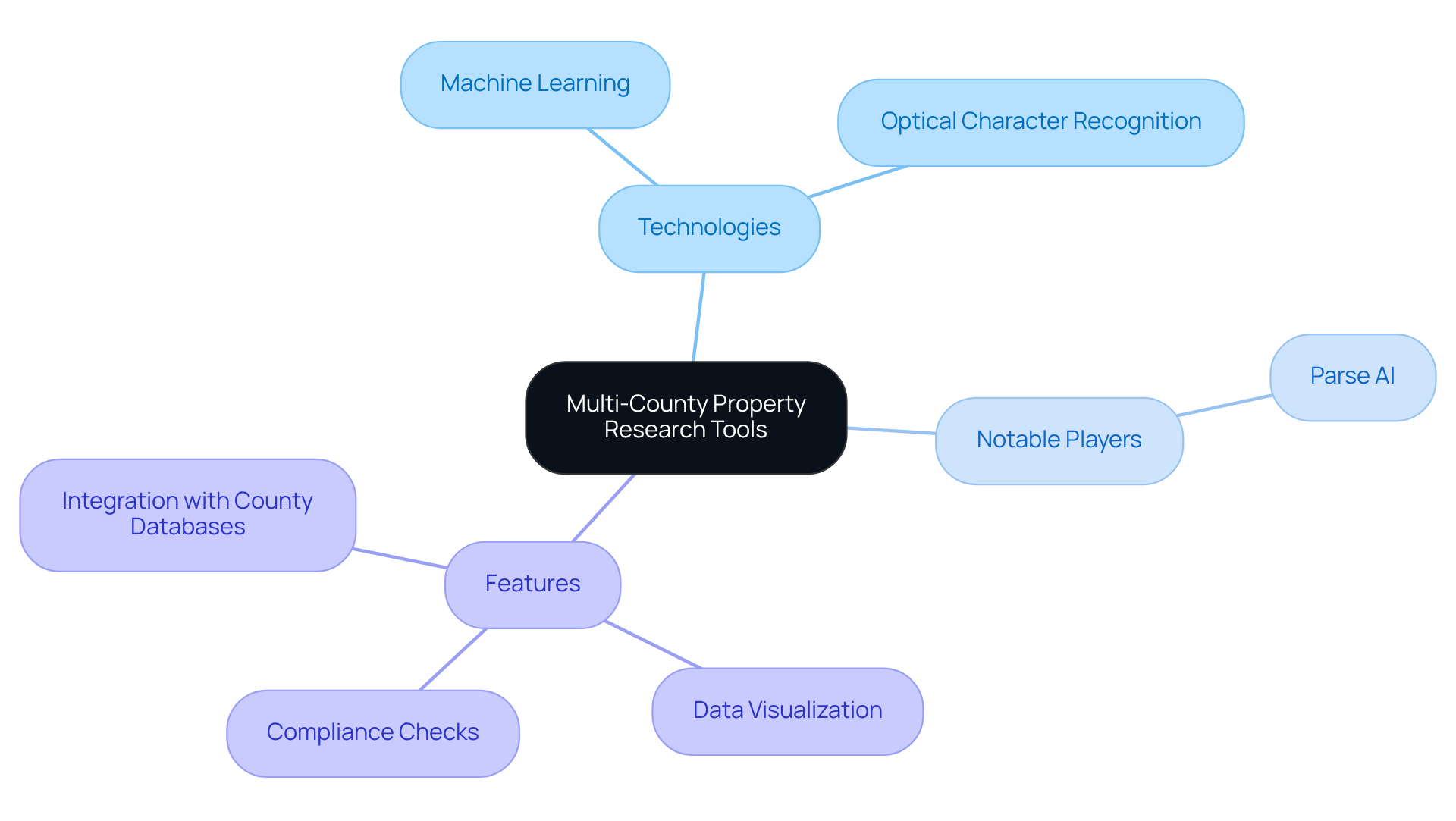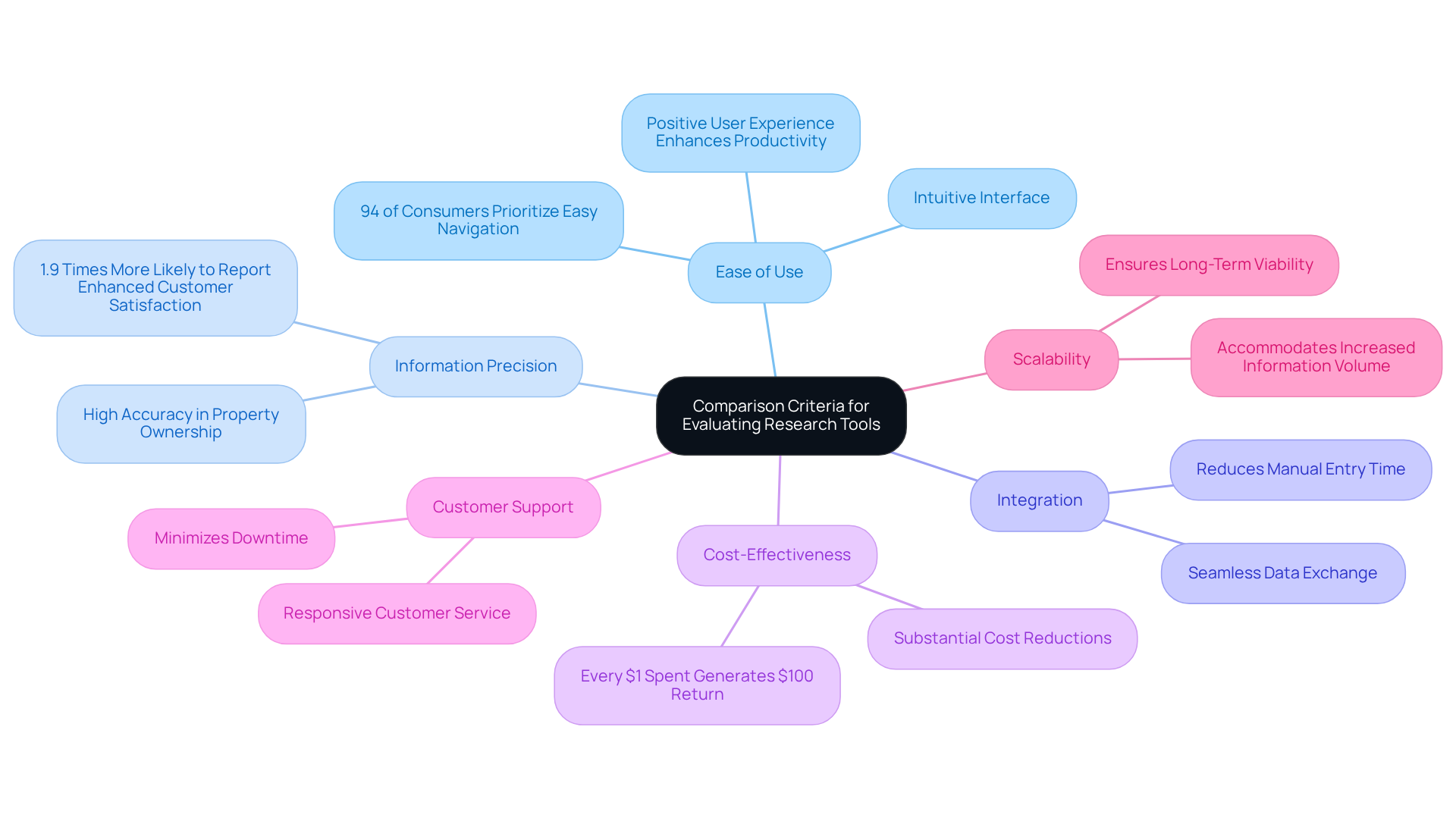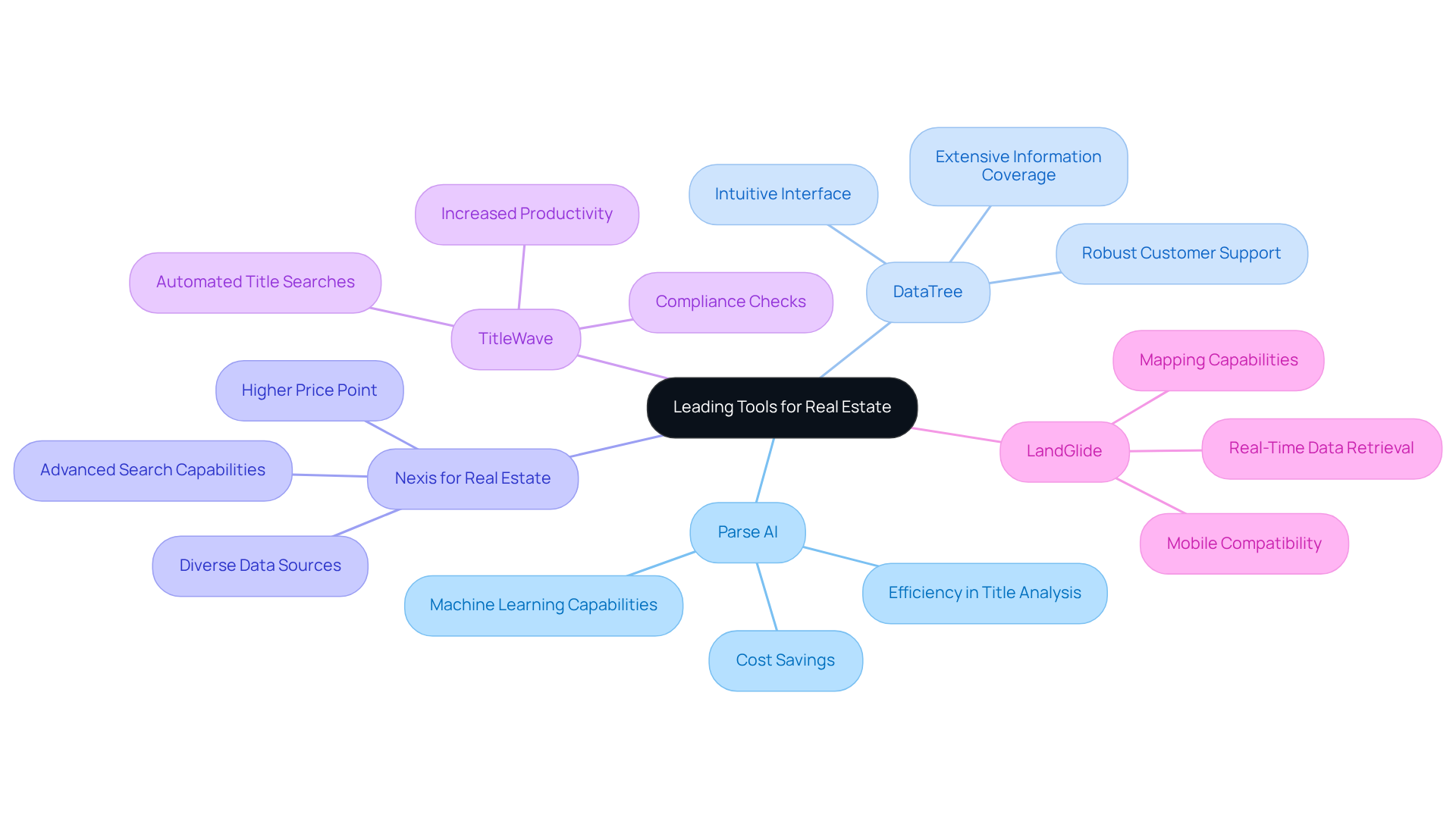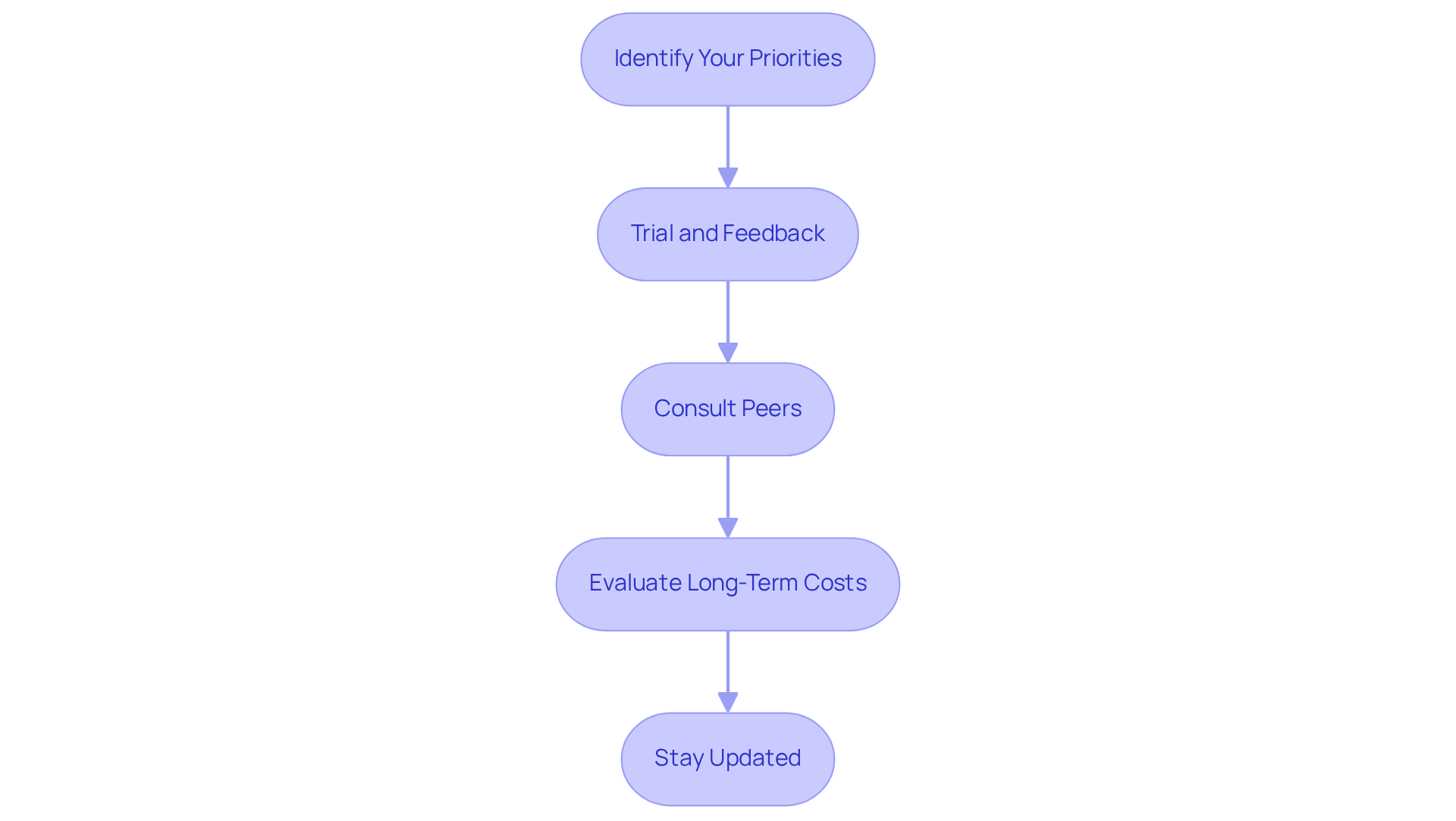Overview
The primary objective of this article is to identify essential tools for conducting multi-county property research with effectiveness. It emphasizes that tools such as Parse AI and DataTree significantly enhance the efficiency of property investigations. These tools offer advanced features, including:
- Automation
- Data integration
- User-friendly interfaces
Consequently, they improve accuracy and reduce research time for real estate professionals, underscoring their value in the industry.
Introduction
The landscape of real estate is continuously evolving, compelling professionals to navigate a complex web of property information across multiple jurisdictions. For those engaged in multi-county property research, leveraging advanced tools has become essential for enhancing efficiency and accuracy. However, with numerous options available, the challenge remains: how can one determine which tools truly excel in usability, precision, and integration? This article explores four essential tools that can revolutionize property research, providing insights into their unique features and the criteria that define their effectiveness.
Overview of Multi-County Property Research Tools
The tools for multi-county property research serve a crucial role for real estate experts, enabling them to effectively collect and examine property information across various jurisdictions. These advanced tools leverage cutting-edge technologies, including machine learning and optical character recognition, to enhance the precision and speed of title examination. Notable players in this domain, such as Parse AI, concentrate on automating the extraction of information from title documents. Additionally, other platforms may provide diverse features, including:
- Data visualization
- Compliance checks
- Integration with county databases
Understanding the functionalities of tools for multi-county property research is essential for specialists aiming to optimize their processes and reduce the time dedicated to property investigation.

Comparison Criteria for Evaluating Research Tools
When assessing multi-county property research tools, several key criteria should be prioritized:
-
Ease of Use: An intuitive interface is essential for maximizing efficiency. Tools must be designed to minimize the learning curve, allowing users to navigate effortlessly without extensive training. A positive user experience significantly enhances productivity; in fact, 94% of consumers prioritize easy navigation as the most important feature in digital platforms. This statistic underscores the critical role that ease of use plays in the effectiveness of property analysis tools.
-
Information Precision: The dependability of extracted information is paramount. To prevent costly errors in real estate transactions, tools for multi-county property research must ensure high accuracy in property ownership and title details, as inaccuracies can lead to significant issues. Case studies reveal that organizations with advanced research practices are 1.9 times more likely to report enhanced customer satisfaction, illustrating the importance of accurate information in maintaining client trust.
-
Effective integration with existing systems and databases through tools for multi-county property research streamlines workflows and boosts overall efficiency. Tools that facilitate seamless data exchange significantly reduce the time spent on manual entry, enhancing operational coherence.
-
Cost-Effectiveness: Evaluating the pricing structure relative to the features offered is vital for budget-conscious professionals. Solutions that provide substantial cost reductions while maintaining high functionality, such as tools for multi-county property research, can yield a significant return on investment; research indicates that each dollar spent on these tools can generate a return of $100. This compelling statistic highlights the financial benefits of investing in efficient research resources.
-
Customer Support: Access to responsive customer service is a critical factor, particularly when technical issues arise. Reliable assistance minimizes downtime and ensures that users can effectively utilize the tools for multi-county property research available to them. Citing statistics or expert quotes emphasizing the importance of customer support would further bolster this criterion's credibility.
-
Scalability: As businesses expand, tools should accommodate increased information volume and complexity without compromising performance. Scalable solutions serve as tools for multi-county property research, enabling organizations to adapt to evolving demands while ensuring long-term viability and efficiency in property analysis. Specific examples or statistics illustrating the advantages of scalable solutions would strengthen the argument in this area.

In-Depth Analysis of Leading Tools
-
Parse AI: Renowned for its sophisticated machine learning capabilities, Parse AI excels in swiftly retrieving information from title documents, significantly reducing the time necessary for title analysis. Its seamless integration with existing databases enhances usability, establishing it as the preferred choice among real estate professionals who prioritize efficiency and accuracy in their workflows, particularly through the use of tools for multi-county property research. Industry experts assert that Parse AI's innovative approach has resulted in substantial cost savings compared to traditional methods.
-
DataTree: This platform offers a thorough investigation of property information, providing access to a vast array of public records. Its intuitive interface, coupled with robust customer support, caters to both novices and experienced users, ensuring a seamless experience. Satisfaction ratings underscore the effectiveness of tools for multi-county property research in simplifying property investigations, with numerous users praising their extensive information coverage and usability.
-
Nexis for Real Estate: Focused on public records, Nexis accelerates investigation processes by delivering a diverse range of data sources. Its advanced search capabilities enable users to quickly locate relevant information, although it is often associated with a higher price point. Industry leaders recognize its effectiveness in enhancing investigative efficiency, making it an invaluable tool for dedicated scholars who utilize tools for multi-county property research. A recent evaluation revealed that Nexis significantly reduced investigation time, allowing users to concentrate on analysis rather than information collection.
-
TitleWave: Designed specifically for title professionals, TitleWave features automated title searches and compliance checks, ensuring high accuracy in results. However, its complexity may necessitate additional training for newcomers, which could pose a challenge for companies aiming to onboard staff swiftly. A case study indicated that firms utilizing TitleWave experienced a 30% increase in productivity after training their staff on the platform.
-
LandGlide: A mobile-compatible solution, LandGlide empowers users to access property information while on the move, making it particularly advantageous for field studies. Its mapping capabilities enhance the user experience, though it may lack some advanced features found in desktop applications. Overall, LandGlide is lauded for its convenience and accessibility in property data exploration, with users highlighting its effectiveness in real-time data retrieval during site visits.

Selecting the Right Tool for Your Title Research Needs
Selecting the appropriate tools for multi-county property research requires a comprehensive evaluation of your specific needs against the features offered by each option. Consider these essential steps to guide your decision-making process:
- Identify Your Priorities: Clearly articulate the factors that are most critical for your workflow—be it speed, accuracy, cost, or user-friendliness. As Michael Howard asserts, "No solution can be all things to all people and instead should focus on doing one thing exceptionally well."
- Trial and Feedback: Utilize trial periods provided by many applications. This enables your team to evaluate usability and effectiveness, ensuring the software meets your operational demands.
- Consult Peers: Connect with fellow real estate professionals to glean insights from their experiences with various resources. Their feedback can illuminate strengths and weaknesses that may not be immediately evident.
- Evaluate Long-Term Costs: Look beyond the initial purchase price. Factor in ongoing subscription fees and any additional costs for features that may be essential for your operations. For example, annual subscription costs can differ significantly, influencing your budget.
- Stay Updated: The technology landscape is perpetually evolving. Regularly assess your tool's performance and remain receptive to exploring new solutions that could bolster your efficiency and effectiveness in property research.

Conclusion
In the realm of multi-county property research, the right tools can significantly enhance the efficiency and accuracy of real estate professionals. By leveraging advanced technologies, these tools streamline the process of gathering and analyzing property information across various jurisdictions, ultimately optimizing workflows and reducing the time spent on investigations.
This article highlights several key criteria for evaluating these essential research tools:
- Ease of use
- Information precision
- Effective integration
- Cost-effectiveness
- Customer support
- Scalability
Each of these factors plays a critical role in ensuring that real estate experts can perform their tasks with maximum efficiency and minimal errors. Furthermore, an in-depth analysis of leading tools like Parse AI, DataTree, Nexis for Real Estate, TitleWave, and LandGlide illustrates the diverse functionalities available to meet the varying needs of professionals in the industry.
Ultimately, selecting the right tool for multi-county property research is a crucial decision that can have significant implications for productivity and success. By carefully considering individual priorities, utilizing trial periods, consulting peers, evaluating long-term costs, and staying updated on technological advancements, real estate professionals can make informed choices that enhance their research capabilities. Embracing the right tools not only fosters operational excellence but also positions professionals to better serve their clients in an ever-evolving market.
Frequently Asked Questions
What is the purpose of multi-county property research tools?
Multi-county property research tools are designed to help real estate experts collect and examine property information across various jurisdictions efficiently.
What technologies do these tools utilize?
These tools leverage advanced technologies such as machine learning and optical character recognition to enhance the precision and speed of title examination.
Who are some notable players in the multi-county property research tools market?
Notable players in this domain include Parse AI, which focuses on automating the extraction of information from title documents.
What additional features do some property research platforms offer?
Some platforms may provide features such as data visualization, compliance checks, and integration with county databases.
Why is it important for specialists to understand these tools?
Understanding the functionalities of these tools is essential for specialists to optimize their processes and reduce the time spent on property investigation.




